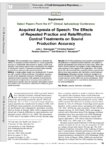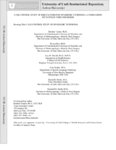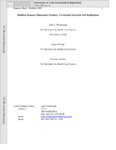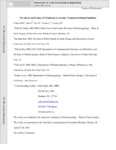TO
1 - 25 of 4
| Creator | Title | Description | Subject | Date | ||
|---|---|---|---|---|---|---|
| 1 |
 | Wambaugh, Julie L. | Acquired apraxia of speech: the effects of repeated practice and rate/rhythm control treatments on sound production accuracy | Purpose: This investigation was designed to elucidate the effects of repeated practice treatment on sound production accuracy in individuals with apraxia of speech (AOS) and aphasia. A secondary purpose was to determine if the addition of rate/rhythm control to treatment provided further benefits be... | 2012-01-01 | |
| 2 |
 | Roy, Nelson | Case-control study of risk factors for spasmodic dysphonia: a comparison with other voice disorders | Objectives: This epidemiology study examined risk factors uniquely associated with spasmodic dysphonia (SD). Study Design: Case-control. Methods: A questionnaire was administered to 150 patients with SD (with and without coexisting vocal tremor) and 136 patients with other structural, neurological, ... | 2012-01-01 | |
| 3 |
 | Wambaugh, Julie L. | Modified response elaboration training: a systematic extension with replications | Background: Response Elaboration Training (RET; Kearns, 1985) has been found to consistently result in increased production of content in discourse with persons with aphasia. Positive treatment effects have been reported for persons representing a variety of aphasia types and severities. RET was mod... | 2012-01-01 | |
| 4 |
 | Roy, Nelson | Prevalence and causes of dysphonia in a large treatment-seeking population | Objective: To determine the prevalence and common causes of dysphonia as diagnosed by primary care physicians (PCPs) and otolaryngologists, and to evaluate differences in etiologies offered by these providers. Study Design: Retrospective analysis of data from a large, nationally representative admin... | 2012-01-01 |
1 - 25 of 4
